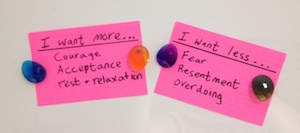Creating a “Want more – Want less” list.

“Perfectionism is a self-destructive and addictive belief system that fuels this primary thought: If I look perfect, and do everything perfectly, I can avoid or minimize the painful feelings of shame, judgment, and blame.”
Brené Brown – The Gifts of Imperfection: Let Go of Who You Think You’re Supposed to Be and Embrace Who You Are.
Growing up, during our formative years, we interpret messages we get from our parents as “not enough.” Not being good enough, smart enough, thin enough, productive enough. Simply take the phrase “Not…enough” and you can easily fill in the blank many times over and own being “not good enough.” When trying to meet our parents’ expectations, we become programmed to believe that we’re only enough if we’re perfect.
As food addicts, our major coping mechanism is the tendency to eat over our emotions. It means that if we are not in recovery, the shame, judgment, and blame will eventually lead to uncontrolled eating. Feeling not good enough creates stress, and stress is unhealthy and dangerous for our recovery. Striving for Progression rather than Perfection helps us be more loving towards ourselves and support our recovery.
One of the simplest ways to practice Progression rather than Perfection is by creating a “Want more – Want less” list.
Instead of thinking or saying what you want to stop doing and what you want to start doing, think or say: I want more… I want less…
For example, I recently experienced some worry and fear, which is normal for me when it comes to being a mother. I know in my head that my children are mature and responsible enough to find their way in life, but when they face a challenge my first automatic reaction is fear and worry. I’ve learned over the years that to expect myself to have no fear or worry is unrealistic and leads only to being hard on myself and beating myself up. My new mantra when I experience these emotions is “I want more peace and less worry. I want more serenity and less fear.”
When catching yourself trying to be perfect, make a list of things you want more of and things you want less of in life. Create new mantras.
By the way – the only aspect of recovery where I don’t practice Progression rather than Perfection is the food. We are blessed to have a weighed and measured food plan that keeps us healthy, joyous, and free. I choose to eat exactly what’s on the food plan and I allow myself to strive for perfectionism with the food. In this one distinct area, abstinence is the foundation of my recovery.